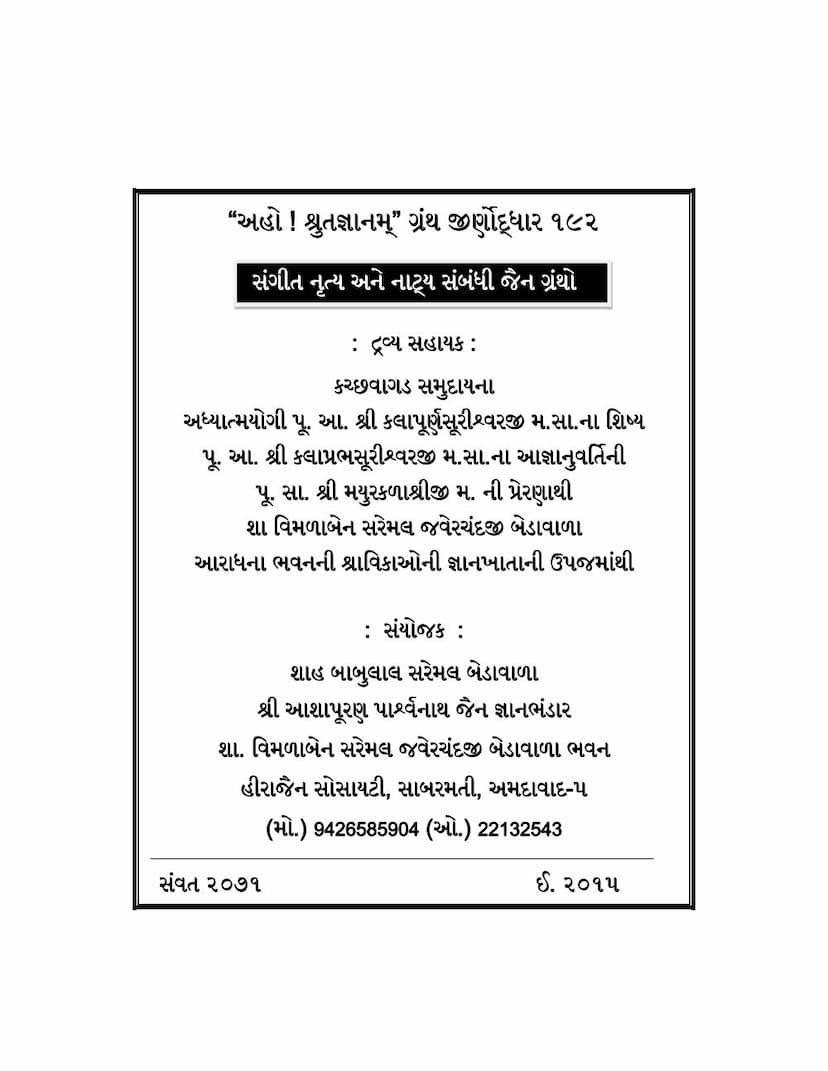Sangit Nrutyo Natya Sambandhi Jain Ullekho Ane Grantho
Added to library: September 2, 2025

Summary
Based on the provided text, here's a comprehensive summary of the Jain text "Sangit Nrutyo Natya Sambandhi Jain Ullekho Ane Grantho" by Hiralal R Kapadia:
Book Title: Sangit Nrutyo Natya Sambandhi Jain Ullekho Ane Grantho (Jain Mentions and Texts Related to Music, Dance, and Drama) Author: Hiralal R Kapadia Publisher: Mukti Kamal Jain Mohanmala
This book, authored by the esteemed scholar Hiralal R Kapadia, is a scholarly exploration of the presence and significance of music, dance, and drama within Jain literature and traditions. It aims to bring to light the various mentions and specific texts from the Jain canon and post-canonical literature that relate to these performing arts.
Key Themes and Content:
- Jain Heritage of Performing Arts: The book establishes that Jain tradition, contrary to any perception of strict austerity, has a rich heritage of engaging with and documenting music, dance, and drama.
- Agamic and Post-Agamic References: Kapadia meticulously traces references to these arts in foundational Jain scriptures (Agamas) like Sthananga, Anuyogadvara, Rayapaseniy, and Uttaradhyayana. He then extends his research to post-agamic literature, including commentaries, Prakaranas, and the works of prominent Jain authors.
- Specific Arts Discussed:
- Music (Sangit): The book delves into the various aspects of music, including:
- The etymology and multiple meanings of the term "Sangit."
- The components of music: vocal (Geet), instrumental (Vadya), and dance (Nritya).
- The classification of music, including mentions of different types of songs, melodies (Ragas), and musical scales (Gramas).
- The concept of Swaras (notes) – their names (Sajja, Rishabha, Gandhara, Madhyama, Panchama, Dhaivata, Nishada), their positions, their origins (from birds and animals, and from musical instruments), their fruits (benefits), and their deities.
- The detailed descriptions of Swaramandal, including 19 specific points of discussion found in the Agamas.
- The concept of 49 Tanas (musical patterns).
- The discussion of various musical instruments mentioned in Jain texts.
- The categorization of Ragas and Raginis.
- The mention of specific musical compositions like Mahavir Ragmala.
- The concept of "Deshi" (folk tunes/styles).
- Dance (Nrutya): The book explores:
- The definition and evolution of dance as an art form.
- The distinction between various dance forms like Tandava, Lasya, Nritta, etc.
- The mention of specific dance styles and techniques, including detailed descriptions of Karanas (dance movements), Angaharas (choreographic sequences), and Hastas (hand gestures).
- The famous examples of dance performances by celestial beings (like Urvashi, Menaka, Tilottama) and even during auspicious events related to Tirthankaras.
- The practice of dance in rituals and devotional contexts, including "Nritya-Puja" (dance worship).
- The specific dance practices mentioned in the lives of Jain figures, including the elaborate descriptions of the celestial dances performed before Lord Mahavir.
- Drama (Natya): The text examines:
- The origins and evolution of drama.
- The concept of Natya as a synthesis of music, dance, and instrumental performance.
- The mention of 32 types of Natakas (dramas) that were performed in grand assemblies and before Tirthankaras, described in detail with their symbolic representations.
- The specific performances by celestial beings like Ishan Indra and Suryabha.
- The inclusion of "Natya-Puja" within devotional rituals.
- The use of dramatic performances for conveying religious and moral teachings.
- The literary analysis of Jain dramatic works and the historical context of their performance.
- Music (Sangit): The book delves into the various aspects of music, including:
- Scholarly Approach: Kapadia's work is characterized by its meticulous research, drawing upon a wide range of Jain texts and cross-referencing information. He provides detailed explanations of technical terms and discusses variations in textual interpretations and traditions.
- Biographical Information: The book also includes valuable biographical sketches of prominent scholars and monks who contributed to the study and preservation of Jain literature, including the author Hiralal R Kapadia himself, Muni Yashovijayji, and Prof. Ramanlal Chhotalal Mehta, offering insights into their dedication and scholarly pursuits.
- Preservation and Digitization: The "Aho Shruta Gnanam Granth Jernoddhar" project, associated with the publisher, is highlighted as a significant effort to scan and preserve rare and inaccessible ancient Jain texts, making them available on DVDs and online, which contributes to the accessibility of the information discussed in the book.
Significance:
"Sangit Nrutyo Natya Sambandhi Jain Ullekho Ane Grantho" is a foundational text for anyone interested in the intersection of Jainism and the performing arts. It demonstrates the sophisticated understanding and integration of music, dance, and drama within the Jain cultural and religious landscape, challenging any potential misconceptions about their exclusion. Kapadia's work serves as an invaluable resource for scholars, researchers, and practitioners seeking to understand this often-overlooked aspect of Jain heritage.